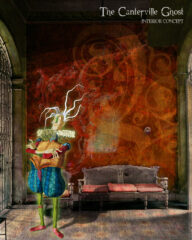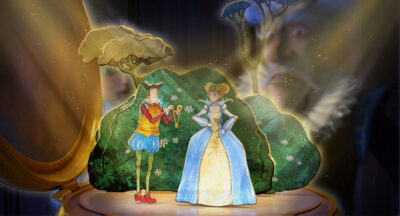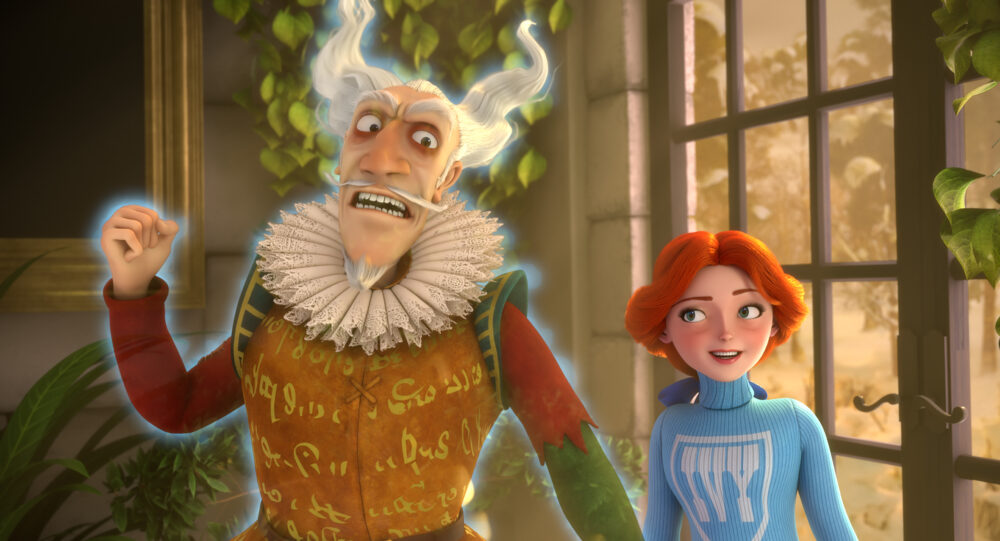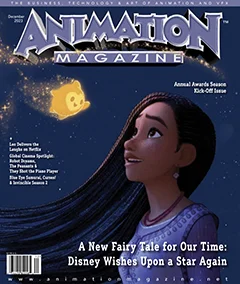|
Getting your Trinity Audio player ready...
|
The new CG-animated movie The Canterville Ghost is the latest charming adaptation of the beloved Oscar Wilde tale. The film, which is directed by Kim Burdon, co-directed by Robert Chandler and produced by Chandler and Gina Carter, features a stellar voice cast which includes Stephen Fry, Hugh Laurie, Freddie Highmore, Emily Carey, David Harewood, Toby Jones and Imelda Staunton. Distributed by Blue Fox Entertainment and Shout! Studios, the film follows the adventures of a modern American family that moves to a classic mansion in England, only to find it haunted by the ghost of Sir Simon de Canterville.
We had the pleasure of interviewing producer and co-director Chandler — whose many credits include The Amazing Maurice, StarDog and TurboCat and The Deep — to learn more about this lovely new adaptation of Wilde’s book.
Animation Magazine: First up, congratulations for bringing this movie to the screen. We know you were working on it for many years. Can you tell us when you decided to do an animated version of this classic tale, and why did you believe it would be a good story to tell in animation?
Robert Chandler: Director Kim Burdon had the idea for an animated version of Canterville about 14 years ago. Kim’s an animator and an excellent artist, and he showed me his drawings for the characters. I fell in love with them immediately, partly because they looked so unique and …. vulnerable. I always look for a quality of vulnerability in actors and characters. Kim suggested we do it for television, but I knew straight away these characters had to become a movie.
The story had been told already in live action, with the ghost, Sir Simon, portrayed by such luminaries as Charles Laughton, John Gielgud and David Niven. I felt we could bring an other-worldly quality to the story via animation — really push the hauntings and solve the problem Oscar Wilde avoids in his story, which is to show what happened when Virginia confronts Death and breaks Sir Simon’s curse in the walled garden in the tale’s climax.

What was the toughest aspect of launching it after several years in development?
Being honest, the hardest part was making the movie for a fifth of the budget that we set out to raise. We knew this wasn’t a movie with lots of key characters and many locations, so we pulled back where we could … For example, we scaled down what was once a big party with a hundred guests and an orchestra in a garden marquee to a dinner party in a room (already built in the house) with a three-piece jazz band! But I knew we had a great screenplay and a tale with plenty of heart, and that’s what we held on to. I told myself I could make cuts as long as I was remaining true to the narrative and what certain events meant to the characters, even if those events were scaled back.
Where was the animation produced and which tools were used?
We had a brilliant partner in Toonz Animation in India. This was to be Toonz’s first feature film (they had been producing successfully for television for many years) and they threw everything at it. We used their pre-production storyboard facility in New Zealand, animated in their main studio in Trivandrum, Kerala in India and post-produced at their affiliate company Telegael in Galway, Ireland. Meanwhile, all the audio was recorded and then post-produced at Splice in London. I am so proud of what we were all able to achieve, everybody pulling together to make our Fabergé Egg of a film. (I like to think of it as a Fabergé Egg because it’s beautiful but a little strange.)
What do you love about this story and your version of it?
I love Oscar Wilde through and through — his life, his wit, his ability to create character and moment, the stand he took, the heart of the man. The Canterville Ghost is a terrific example of how he was able to write about characters in such a way that you knew he loved them even while satirizing who they were and the worlds from which they were drawn.
In the story, it would have been easy to ridicule the Americans or the English aristocracy, but he never ridicules them; he mocks them, for sure, but he also looks after them and makes sure they are treated fairly by the narrative. We wanted a similar tone running through our film. In adapting it for the screen, we cut back on some characters while introducing others — for example, we placed a ghost-hunter in there to up the stakes in the third act and we brought out the romance of the piece in the friendships and relationships between Sir Simon and Virginia, Virginia and Henry, and Sir Simon and his wife, Eleanor.

The one thing I am very proud of is that we show what happens in the third act. Oscar drew a veil over the goings-on when Virginia confronted Death and asked that Sir Simon’s soul be released. He placed his emphasis on the family searching for Virginia, wondering where she had gone. This would have been unsatisfying on-screen. And so we take the viewers and plummet them right into the walled garden and show what happens in that confrontation via a big, emotional duel scene. This, I think, is what I love most about it. That we were faithful to the spirit of Oscar Wilde’s story while not being afraid to add and adapt in order to turn it into a fulfilling movie.
Can you tell us a bit about the style of animation and visual inspirations for the movie?
The animation was tricky because we wanted to create a “real world” that felt grounded, in order for the walled garden in the third act to feel more “unreal.” And we wanted to keep our characters relatively human, both in proportion and in action. There’s not too much squash-and-stretch going on. That was a gamble, of course, because of the expectation distributors and viewers have of animated features. They think they are children’s films where everything is larger than life! Of course, they are not all this way … or shouldn’t be. We were making a family film, for sure, but a film that wasn’t afraid to explore themes of love, death and sacrifice (the holy trinity) in a world that I once pitched as “Downton Abbey gets haunted.” It was never easy. I often felt we were creating our own aesthetic. And you have to remember this was all being done during a pandemic lockdown where we were briefing teams remotely.

Do you have any favorite moments in the movie?
My favorite moments are the moment Henry catches Virginia in his arms when she falls from the garden wall and he says, “Hello!” as though surprised by her sudden arrival, as though she had just dropped down from heaven like an angel and he had never seen her before. That one word was improvised by Freddie Highmore and I knew when I heard it that it was very funny and was going to stay. Virginia of course looks at him and says bluntly, “You can put me down now.” And then later, when Virginia and Henry take up their swords together to fight the Big Bad Guy in the third act, you can see how well they work together and how much they now mean to each other. I am such a romantic.
I also love the illustrations in the book Virginia reads about Canterville, and the magical locket moments that give us the backstory.
Finally, a shout-out to Mr. Tibbs, the teddy bear. He belonged to Lord Monroe, the owner of Canterville whom we see Simon scaring out of his wits in the pre-titles sequence. If you watch closely, later in the film, you’ll see Mr. Tibbs on the floor next to the skeleton in Sir Simon’s cell. We don’t make a big thing of it, but it’s there. Simon had taken the teddy bear and kept him as a companion … it was a visual clue to Sir Simon’s character, his essential loneliness and the sadness of his curse.
How were you able to attract such a fantastic cast?
When we started the film, we pitched it to Stephen Fry and his producer/business partner Gina Carter. They both fell in love with the screenplay and the designs and came on board as partners. Stephen and Gina became actively involved in the production, and this opened up a range of blue chip British actors for us. Here’s a thing, we made the first scratch recording with our cast in 2012 … and then spent a decade putting the film’s finances together. When we had finally achieved the full finance raise, we went back to our cast and every single one stayed the course (aside from Virginia and the Twins, where, because of their ages, we had used older actors for the scratch. We were able to cast these roles afresh). It is a great cast and they elevate the film.
I’m going to single out Emily Carey as Virginia. She brought so much energy and spirit to her role, and understood instinctively the strength and vulnerability of the character. After screenings in Annecy, most people coming up to me afterwards were saying how much they loved Virginia, how strong and independent she was. After Annecy, we changed the emphasis on the poster design and put Virginia up front.

What is your take on the overall state of animation in 2023?
It’s very tough, actually. Cinemas are having hard times, the streamers’ production budgets have been reduced radically. Where do we place animated films? How can they earn their money back? Where once we had the jubilation of Netflix proudly proclaiming a new era for animation, now we are seeing scales and budgets cut right back. Projects being cancelled. I’m being a bit cautious in what I say here but, boy, has it been difficult. And will continue to be so for some time.
Part of the issue is the marketing of animated features. I feel I’ve been on a mission for many years to have animation regarded not as a genre, but simply as one mode of cinematic storytelling, a mode that works for adults, children, families. We of course were finding that many distributors were only able to sell the film as a children’s film, and I wanted it to be wider than that. But unless distributors can put the film into the “children’s film” box, they probably couldn’t market it successfully.
I’d like to see animation spread its wings and attract new audiences of all ages — maybe the critical success of Guillermo Del Toro’s Pinocchio will help that? Perhaps our previous film, The Amazing Maurice will help that, too. And maybe Canterville in a small way will contribute to changing how people regard animation.
What was the biggest lesson you learned about bringing this movie to animated life?
I have three lessons:
- Never give up.
- Work with good people.
- Never underestimate the value of a great actors, not because they attract finance, but because they are great actors and they bring so much to the heart, energy and personality of a film.
One last question: What would you like audiences to take away from your movie?
A lovely moment in the story of this production is I was talking on the phone to one of the financiers during Cannes and she told me she watched the film with her son (he was around eleven years old). When it was over, she asked him what the film was about and he replied “it’s about not wasting time and making the most of things while you can”. I almost burst into tears when she told me. That’s our takeaway, right there.
The Canterville Ghost opens in U.S. theaters through Blue Fox Entertainment and Shout! Studios on Friday, October 20. Visit the film’s page at bluefoxentertainment.com to find screening locations. The movie will be available digitally and on demand Dec. 5.

















 Win a Funko X Lilo & Stitch Prize Pack!
Win a Funko X Lilo & Stitch Prize Pack! 


